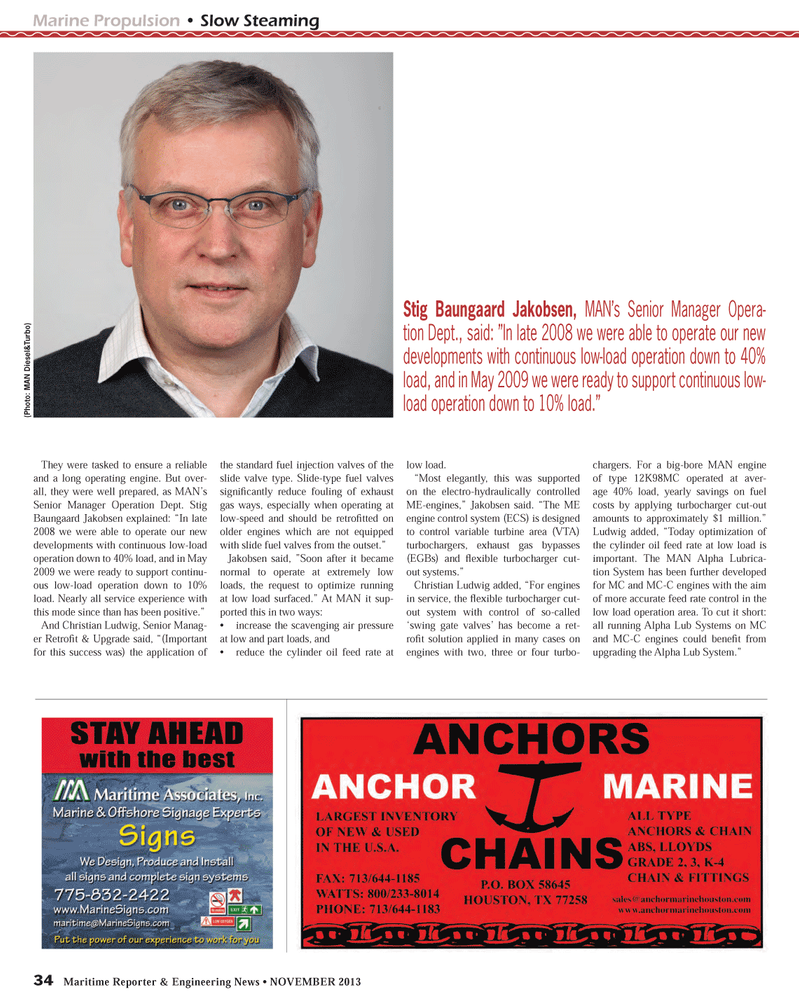
Page 34: of Maritime Reporter Magazine (November 2013)
Marine Propulsion Annual
Read this page in Pdf, Flash or Html5 edition of November 2013 Maritime Reporter Magazine
34 Maritime Reporter & Engineering News ? NOVEMBER 2013 Stig Baungaard Jakobsen, MAN?s Senior Manager Opera- tion Dept., said: ?In late 2008 we were able to operate our new developments with continuous low-load operation down to 40% load, and in May 2009 we were ready to support continuous low- load operation down to 10% load.? (Photo: MAN Diesel&Turbo) Marine Propulsion ? Slow SteamingThey were tasked to ensure a reliable and a long operating engine. But over- all, they were well prepared, as MAN?s Senior Manager Operation Dept. Stig Baungaard Jakobsen explained: ?In late 2008 we were able to operate our new developments with continuous low-load operation down to 40% load, and in May 2009 we were ready to support continu-ous low-load operation down to 10% load. Nearly all service experience with this mode since than has been positive.?And Christian Ludwig, Senior Manag-er RetroÞ t & Upgrade said, ?(Important for this success was) the application of the standard fuel injection valves of the slide valve type. Slide-type fuel valves signiÞ cantly reduce fouling of exhaust gas ways, especially when operating at low-speed and should be retroÞ tted on older engines which are not equipped with slide fuel valves from the outset.?Jakobsen said, ?Soon after it became normal to operate at extremely low loads, the request to optimize running at low load surfaced.? At MAN it sup- ported this in two ways:? increase the scavenging air pressure at low and part loads, and? reduce the cylinder oil feed rate at low load.?Most elegantly, this was supported on the electro-hydraulically controlled ME-engines,? Jakobsen said. ?The ME engine control system (ECS) is designed to control variable turbine area (VTA) turbochargers, exhaust gas bypasses (EGBs) and ß exible turbocharger cut- out systems.?Christian Ludwig added, ?For engines in service, the ß exible turbocharger cut- out system with control of so-called ?swing gate valves? has become a ret- roÞ t solution applied in many cases on engines with two, three or four turbo-chargers. For a big-bore MAN engine of type 12K98MC operated at aver- age 40% load, yearly savings on fuel costs by applying turbocharger cut-out amounts to approximately $1 million.? Ludwig added, ?Today optimization of the cylinder oil feed rate at low load is important. The MAN Alpha Lubrica- tion System has been further developed for MC and MC-C engines with the aim of more accurate feed rate control in the low load operation area. To cut it short: all running Alpha Lub Systems on MC and MC-C engines could beneÞ t from upgrading the Alpha Lub System.? MR #11 (34-41).indd 34MR #11 (34-41).indd 3411/11/2013 11:59:57 AM11/11/2013 11:59:57 AM

 33
33

 35
35
